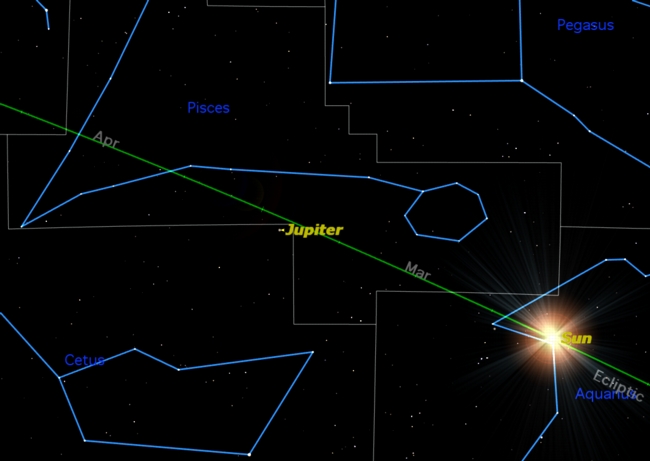Jupiter's Move Into Whale Constellation Highlights Zodiac Boundaries

The astrology world has been abuzz recently with the "discovery" of a new zodiac constellation, Ophiuchus. But the planet Jupiter is making a splash in another part of the sky, a cosmic ocean of constellations.
On Thursday, Feb. 24 at 9:09 p.m. EST (0109 Feb. 25 GMT), Jupiter will leave the familiar confines of the constellation Pisces, the Fish, for a brief sojourn into the "wilds" of the constellation Cetus for about two weeks.
Yes, that's Cetus the Whale.
By March 8 at 7:40 a.m. EST (1240 GMT), Jupiter will return to the safety of Pisces.
When the International Astronomical Union redrew the constellation boundaries in 1930, they put one corner of Cetus perilously close to the ecliptic – the path that the sun appears to follow in the sky over the course of one year.
The ecliptic (and the sun) neatly miss Cetus, but the planets – because their orbits are not in exactly the same plane as the Earth's – are not always so fortunate.
Jupiter is currently just over a degree south of the ecliptic, which causes it to spend 12 days crossing that little corner of Cetus which pokes up into Pisces. Astronomers measure distances in the sky in degrees, with 10 degrees equal to what your fist held at arm's length can cover.
Breaking space news, the latest updates on rocket launches, skywatching events and more!
What does this mean in the real world?
Very little, since the boundaries of the constellations are nothing more than lines drawn arbitrarily on the celestial sphere.
But a similar situation can arise when the planets (or the moon) are close to the border between the constellations Taurus and Gemini. If they are more than half a degree south of the ecliptic, they can slip down into the constellation Orion.
This article was provided to SPACE.com by Starry Night Education, the leader in space science curriculum solutions.

Geoff Gaherty was Space.com's Night Sky columnist and in partnership with Starry Night software and a dedicated amateur astronomer who sought to share the wonders of the night sky with the world. Based in Canada, Geoff studied mathematics and physics at McGill University and earned a Ph.D. in anthropology from the University of Toronto, all while pursuing a passion for the night sky and serving as an astronomy communicator. He credited a partial solar eclipse observed in 1946 (at age 5) and his 1957 sighting of the Comet Arend-Roland as a teenager for sparking his interest in amateur astronomy. In 2008, Geoff won the Chant Medal from the Royal Astronomical Society of Canada, an award given to a Canadian amateur astronomer in recognition of their lifetime achievements. Sadly, Geoff passed away July 7, 2016 due to complications from a kidney transplant, but his legacy continues at Starry Night.
